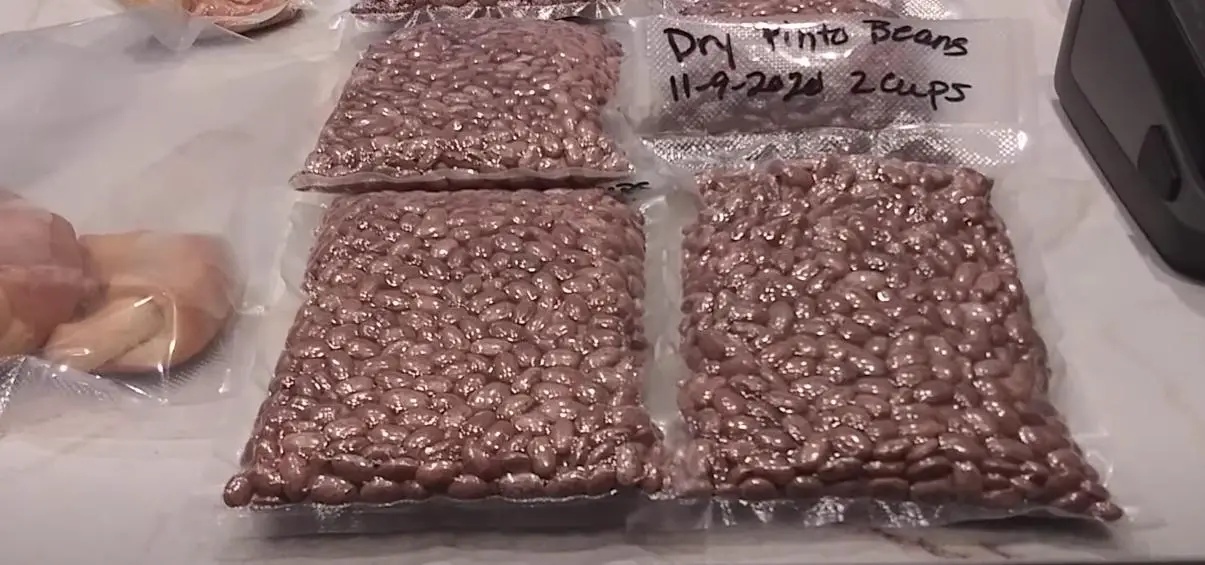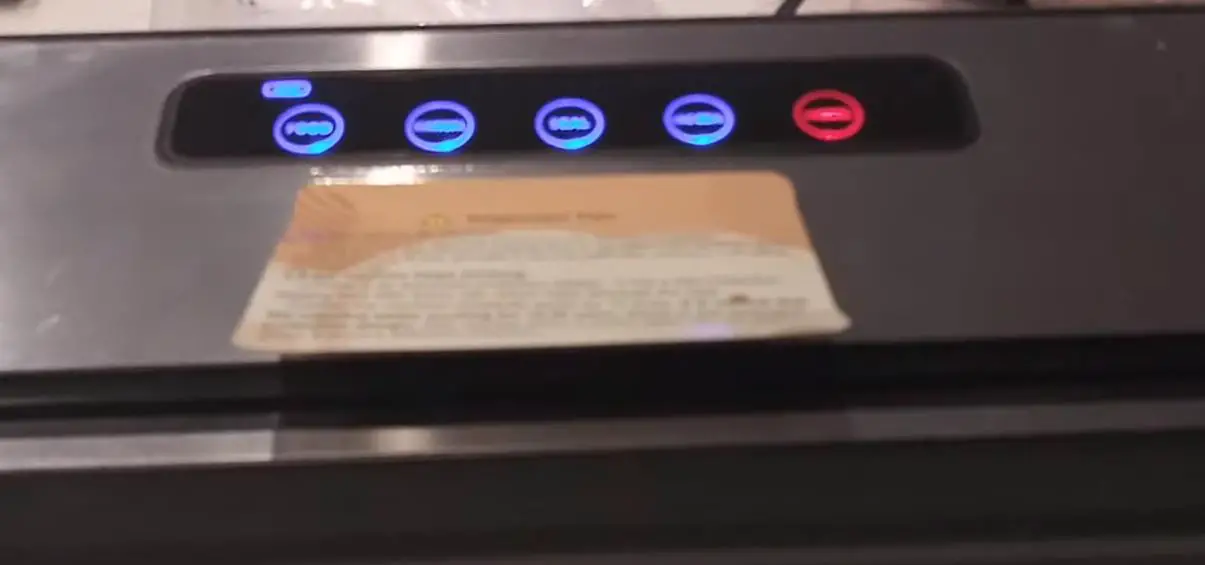Key Takeaways
- You can vacuum seal dry beans, which will help them to last for multiple years
- This storage method is an effective way to keep your beans fresh and edible for a long period of time
- Vacuum-sealing dry beans is a great way to preserve their shelf life and extend their overall lifespan
Have you ever wondered how long you can store dry beans if you vacuum seal them? Or what does the process of vacuuming sealing dry beans entail?
In this article, we will explore all things related to vacuum sealing dry beans – from why people do it, to how long your dried beans will last without being vacuum sealed.
How long will dried beans last if vacuum sealed?
Dried beans are a staple in many kitchens around the world. They’re affordable, nutritious, and versatile, making them a great option for home cooks on a budget.
But how long do dried beans actually last? If you store them properly, vacuum-sealed dried beans can last for years.
Proper storage is key to preserving the quality of your dried beans. Store them in a cool, dry place out of direct sunlight.
An airtight container will help keep moisture and pests out. Vacuum sealing is the best way to ensure that your dried beans stay fresh for as long as possible.
When done correctly, vacuum sealing can extend the shelf life of your dried beans by years.
So if you’re looking to stock up on this pantry staple, don’t hesitate to buy in bulk.

How do you vacuum seal a bean?
Vacuum sealing is a great way to keep your beans fresh for up to five years.
To vacuum seal, a bean, simply put the beans in a special pouch and then put the pouch in a machine that will suck the air out of it.
Once the air is out, the machine will seal the pouch so that no air can get back in.
This process helps to keep the beans from going bad and keeps them tasting fresh for much longer.
What is the best way to store dried beans?
If you’re looking for the best way to store dried beans, vacuum sealing is a great option.
Vacuum sealing will keep your beans fresh and free of moisture, ensuring that they’ll last for a long time.
Plus, it’s easy to do and doesn’t require any special equipment.
How long will beans last in vacuum-sealed bags?
If you’re looking for a way to store your dry beans so they’ll last longer, vacuum-sealing them is a great option.
Dry beans stored in their original plastic packaging will last about one year, but if you vacuum seal them, they can easily last 25 years or more.
Vacuum sealing helps to preserve the beans by preventing air and moisture from entering the package and causing spoilage.
Plus, it’s a great way to save space in your pantry or cupboard since vacuum-sealed bags take up less room than traditional storage containers.
Will vacuum-sealing dry beans preserve them for longer periods of time?
When it comes to storing dry beans, vacuum sealing is one of the best options available.
This method of storage can preserve your beans for much longer periods of time than other methods, making it a great option if you want to keep your beans fresh for extended periods.
One of the main reasons why vacuum sealing works so well for preserving dry beans is because it eliminates all air exposure.
Air is one of the main factors that can cause dried beans to spoil or go bad, so by removing all air exposure, you are effectively extending the shelf life of your beans.
Another reason why vacuum sealing is such an effective way to store dry beans is because it prevents moisture from entering the packaging and causing the beans to spoil.
Moisture can enter into containers through tiny cracks or holes, but with vacuum-sealed packaging, there is no way for moisture to get in and ruin your stored Beans.
If you are looking for a way to extend the shelf life of your dry beans, then vacuum sealing is definitely worth considering.
This storage method can preserve your Beans for much longer than other methods, making it an ideal option if you want to keep them fresh and edible for extended periods of time.
Is it better to store dry beans in a container or in their original packaging?
There are many factors to consider when deciding whether to store dry beans in a container or their original packaging.
One important factor is how airtight the storage option is. Beans that are exposed to oxygen will deteriorate more quickly. Airtight storage options, like vacuum sealing, help to keep beans fresh for longer.
Another factor to consider is moisture. Too much moisture can cause beans to mold and become inedible.
Both containers and original packaging can protect against excess moisture, but containers may be more effective at keeping beans dry since they can be sealed tighter.
Beans should also be stored in a cool, dark place to prevent them from going bad too quickly. This is true regardless of whether you choose a container or original packaging.
Ultimately, the best option for storing dry beans is the one that meets all of your needs in terms of airtightness, moisture protection, and temperature control.
If I accidentally drop my dry beans, are they still good to eat?
If you accidentally drop your dry beans, don’t worry – they’re still safe to eat. However, their quality may diminish over time.
Eating raw or undercooked kidney beans can lead to food poisoning, so be sure to cook them thoroughly before eating.
If you want to keep your dry beans fresh for longer, vacuum sealing is a great option.
Vacuum sealing prevents air from coming into contact with the beans, which can cause them to spoil. It also keeps out moisture, which can cause the beans to become moldy or mildewed.
Can I cook dry beans without soaking them first?
Whether you’re cooking for a large family gathering or meal prepping for the week ahead, vacuum-sealing your food can save you time and money.
And while many people think that vacuum sealing requires special equipment, you can actually do it with things you probably already have in your kitchen.
Here’s how to vacuum seal without a machine: first, find a container that has a tight-fitting lid.
A mason jar or Tupperware container works well. Next, place whatever you want to seal inside the container and press down on it so that there is no air left inside.
Then, put the lid on tightly and place the container in the freezer overnight. The next day, take the container out of the freezer and allow it to thaw completely before opening it.

What’s the difference between white and black dry beans?
When it comes to storing dry beans, there are two main options: white beans and black beans.
While both types of beans are healthy and full of vitamins and minerals, there is a key difference between them: their appearance.
White beans are usually cream-colored, while black beans have black eyes and wrinkles.
So, what does this difference in appearance mean for vacuum sealing?
Well, it turns out that white beans tend to hold up better during the vacuum sealing process.
This is because the cream color of the bean helps to reflect light, which can prevent the formation of an airtight seal.
Black beans, on the other hand, absorb light more readily, which can cause problems with the seal.
So if you’re looking to store your dry beans in a vacuum-sealed container, white beans are generally the way to go.
Final Verdict
Yes, you can vacuum-seal dry beans. Proper storage can extend their shelf life by preventing air from coming into contact with the food. Vacuum sealing is a process that can help preserve food for multiple years.



![Can You Vacuum Seal Tomatoes? [The Proper Way!]](https://vacuumsealerzone.com/wp-content/uploads/2021/08/Can-You-Vacuum-Seal-Tomatoes-350x200.jpg)